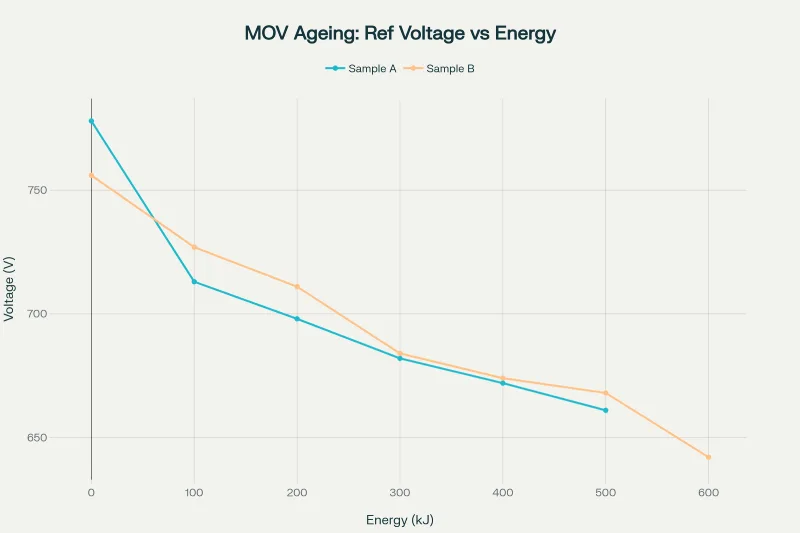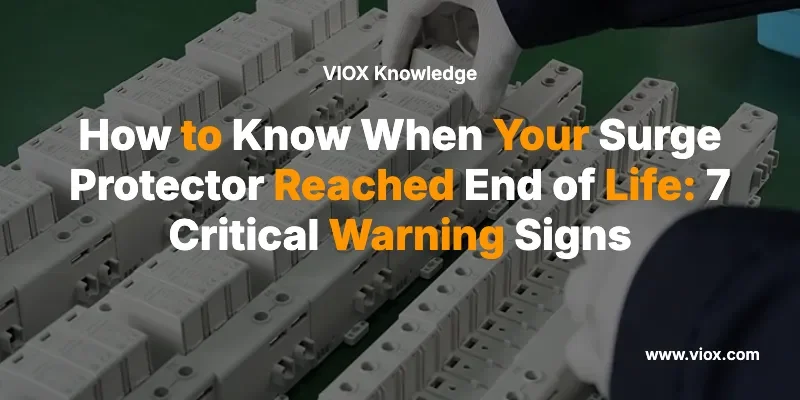s
숨겨진 위험: 서지 보호기 수명 종료가 중요한 이유
서지 보호기 전력 서지 발생 시 과전압을 흡수하는 금속 산화물 배리스터(MOV)라는 부품을 사용합니다. 이러한 부품은 서지를 흡수할 때마다 성능이 점차 저하되어 결국 보호 기능을 완전히 상실합니다. 이러한 경우, 서지 보호기는 전원으로서는 여전히 작동할 수 있지만 전기적 손상에 대한 보호 기능은 전혀 제공하지 못합니다.

무서운 점은 무엇일까요? 서지 보호기가 언제 제대로 작동하지 않는지 정확히 파악하는 것은 사실상 불가능합니다. 그렇기 때문에 투자를 보호하기 위해서는 경고 신호를 인지하는 것이 매우 중요합니다.
서지 보호기가 수명을 다했다는 7가지 중요한 징후
1. 표시등 문제: 첫 번째 경고 시스템
많은 서지 보호기에는 장치가 정상 작동하고 보호 기능을 제공할 때 계속 켜져 있는 LED 진단 표시등이 있습니다. 진단 표시등이 꺼져 있으면 장치를 교체해야 함을 나타냅니다.
찾아야 할 것:
- 녹색불 꺼짐: 보호가 실패했습니다
- 빨간불이 켜짐: 종종 활성 보호보다는 손상이나 수명 종료를 나타냅니다.
- 조명이 전혀 없습니다. 전체 시스템 오류
중요 참고 사항: 이런 조명은 완벽한 시스템은 아니므로 반드시 의지할 수는 없지만, 귀중한 조기 경고 신호를 제공합니다.
2. 눈에 보이는 물리적 손상
가장 뚜렷한 마모 징후는 서지 보호기 자체의 눈에 띄는 손상으로, 타거나, 플라스틱이 녹거나, 전선이 닳거나, 변색된 흔적이 있습니다.
위험 신호에는 다음이 포함됩니다.
- 콘센트 주변의 그을음이나 변색
- 균열 또는 녹은 플라스틱 하우징
- 닳거나 손상된 전원 코드
- 기기 외부에 타 자국이 있음
- 과열로 인한 손상의 징후가 있습니까?
필요한 조치: 물리적인 손상이 있는 경우 즉시 교체하세요.
3. 과열 문제
서지 보호기는 일반적으로 많은 열을 발생시키지 않고 작동합니다. 장치를 만졌을 때 이상하게 뜨겁게 느껴진다면 내부 손상이나 고장의 징후일 수 있습니다.
온도 경고 신호:
- 정상 작동 중 장치가 따뜻하거나 뜨겁게 느껴집니다.
- 플라스틱 하우징은 부드러워지거나 유연해집니다.
- 콘센트에서 나오는 이상한 열
- 최소 부하에도 기기가 뜨거워짐
4. 연령에 따른 교체 일정
3-5년 규칙: 서지 보호기는 일반적으로 일반적인 사용 조건에서 3~5년 동안 지속되며, 이는 사용량과 서지 노출 정도에 따라 달라집니다.
다음과 같은 경우 즉시 교체하세요:
- 귀하의 서지 보호기가 5년 이상 되었습니다.
- 여러 차례 정전이나 폭풍을 경험했습니다.
- 당신은 전력망이 불안정한 지역에 살고 있습니다
- 플로리다와 같은 폭풍이 잦은 지역에서는 2년 이상 된 서지 보호 장치가 쓸모없게 되었을 가능성이 높습니다.
| 환경 | 전형적인 삶 | 이론적 해석 |
|---|---|---|
| 폭풍이 거의 없는 집/사무실 | 5년 | 가벼운 서지 카운트는 MOV를 천천히 악화시킵니다. |
| 뇌우 발생 지역 | 3년 | 잦은 과도 현상으로 인해 줄 예산이 더 빨리 소진됩니다. |
| 높은 결함 에너지를 가진 산업용 패널 | 1~2년 | 더 높은 MCOV와 서지 전류는 노화를 가속화합니다. |
번개가 친 직후나 상태 표시등이 꺼진 경우에는 항상 즉시 교체하세요.
5. 장치 성능 문제
저전압 서지 보호기의 경우 연결된 장비가 제대로 작동하지 않으면 데이터나 신호가 손상된 회로를 통과할 수 없어 고장이 분명해집니다.
성과 지표:
- 연결된 장치에서 간헐적인 전원 문제가 발생합니다.
- 장비가 예기치 않게 중단됨
- 연결된 장치의 데이터 전송 문제
- 일관된 전력 흐름을 받지 못하는 장치
6. 최근 주요 전력 급증 사건
서지 보호기가 심각한 전력 서지를 흡수한 것으로 생각되면 즉시 교체하는 것이 좋습니다.
다음 이벤트 이후에는 교체하세요:
- 귀하의 주변 지역에 번개가 칩니다.
- 대규모 정전 또는 그리드 전환 이벤트
- 집에 영향을 미치는 눈에 보이는 전기 서지
- 다른 전자기기의 오작동을 유발하는 모든 사건
7. 음향 경고 시스템
고급 서지 보호기는 때때로 가청 경보 형태로 수명 종료를 사전에 알려줍니다. 이러한 고급 SPD 중 하나에서 경보가 울리면 서지 보호기가 손상되어 교체해야 함을 즉시 알 수 있습니다.
다음을 들어보세요:
- 삐 소리나 윙윙거리는 소리
- 간헐적 경보 신호
- 장치에서 이상한 소음이 나는 경우
서지 보호기 수명 이해: 몇 년이 중요한 것이 아닙니다
많은 사람들이 오해하는 중요한 개념이 있습니다. 서지 보호기 수명은 년 단위가 아니라 줄(Joule) 단위로 측정된다는 것입니다. 중요한 것은 서지 보호기가 얼마나 많은 줄(Joule)을 흡수했느냐입니다.
줄 평가 시스템
서지 보호기가 흡수하는 전력 서지(power surge)는 앞으로 감당할 수 있는 줄(joule)의 양을 줄입니다. 1000줄 서지 보호기가 1000줄의 충격을 받으면 더 이상 감당할 수 없습니다. 하지만 100줄의 충격을 10번 받거나 1줄의 충격을 1,000번 받아도 마찬가지입니다. 이 모든 것은 누적됩니다.
줄 평가 지침:
- 1,000줄 이상: 고가의 전자제품에 더 좋습니다
- 500-1,000줄: 대부분의 가정용으로 적합합니다
- 500줄 이하: 기본 보호만
수명에 영향을 미치는 환경 요인
열, 습도, 먼지와 같은 환경 조건은 서지 보호기의 성능에 영향을 미칠 수 있습니다. 깨끗하고 서늘하며 건조한 환경에 보관하면 수명을 연장하는 데 도움이 될 수 있습니다.
수명 단축제:
- 습도가 높은 환경
- 과도한 열 노출
- 먼지가 많거나 더러운 환경
- 상당한 전력을 소모하는 장치로 과부하
- 귀하의 지역에서 잦은 전력 변동
서지 보호기를 즉시 교체해야 하는 경우
다음 상황을 기다리지 마세요.
- 주요 폭풍이나 전력 사고 이후
- 표시등이 고장나거나 변경될 때
- 장치에 물리적 손상이 있는 경우
- 고서지 지역에서 3년차에 도달한 후
- 연결된 장치가 제대로 작동하지 않는 경우
서지 보호기의 수명이 다하면 연결된 시스템과 장치는 SPD가 보호하도록 설계된 것과 동일한 전기 서지와 스파이크에 취약해집니다.
서지 보호기 유지 관리를 위한 모범 사례
정기 검사 일정
월별 점검:
- 표시등이 작동하는지 확인하세요
- 물리적 손상이 있는지 확인하세요
- 기기 주변에 적절한 환기가 이루어지도록 합니다.
- 연결된 장비 성능 테스트
연간 교체 고려 사항:
- 제조업체의 권장 사항을 따르고 특정 수명 지침은 사용 설명서나 웹사이트를 확인하세요.
- 지역 전력 상황을 고려하세요
- 연결된 장비의 가치를 평가하세요
고품질 교체 장치 선택
찾아야 할 필수 기능:
- 표시등: 올바르게 작동하는지 쉽게 확인할 수 있는 표시등이 있는 서지 보호기를 찾으세요.
- 높은 줄 정격: 귀중한 전자제품의 경우 최소 1,000줄
- 보증 보호: 많은 제조업체가 연결 장비 보증을 제공합니다.
- 적절한 접지: 전기 시스템과의 호환성을 확보하세요
서지 보호기 효과 극대화
하다:
- 높은 줄 정격을 갖춘 평판 좋은 제조업체의 고품질 제품을 선택하세요
- 장치를 시원하고 건조한 곳에 보관하세요
- 심한 폭풍우 시에는 플러그를 뽑으세요
- 포괄적인 보호를 위해 전체 주택 서지 보호기를 고려하세요
하지 않다:
- 여러 전원 스트립을 데이지 체인 방식으로 연결하지 마십시오. 이렇게 하면 회로에 과부하가 걸리고 효율성이 떨어질 수 있습니다.
- 경고 표지판이나 표시등을 무시하세요
- 손상된 장치를 일반 전원 스트립으로 사용하세요
- 이전 장치가 여전히 보호 기능을 제공한다고 가정합니다.
임종 징후를 무시하는 데 드는 비용
서지 보호기 고장으로 인한 재정적 영향:
- 데스크탑 컴퓨터 교체: $500-$2,000+
- 홈 엔터테인먼트 시스템: $1,000-$5,000+
- 스마트 홈 기기: 기기당 $200-$1,000+
- 데이터 복구 서비스: $300-$1,500+
이를 서지 보호기 교체 비용과 비교해 보세요.
- 고품질 서지 보호기: $20-$100
- 전체 주택 서지 보호: $200-$500 설치됨
계산은 간단합니다. 정기적인 유지 관리를 하면 잦은 교체 필요성이 줄어들고 값비싼 장치 손상도 방지됩니다.
결론: 사전 예방적 교체로 투자를 보호하세요
서지 보호기의 수명이 다한 시점을 파악하는 것은 귀중한 전자 제품을 보호하는 데 필수적입니다. 표시등 고장, 물리적 손상, 과열, 노후화, 성능 문제 등 주요 경고 신호는 교체 시기를 명확히 알려줍니다.
기억하세요: 결함이 있는 서지 보호기는 설치하지 않은 것만큼, 심지어 그보다 더 많은 문제를 일으킬 수 있습니다. 실제로는 아무런 보호도 제공하지 않으면서 잘못된 안전 의식을 심어줄 수 있기 때문입니다.
오늘 행동하세요:
- 현재 서지 보호기를 검사하세요 위의 7가지 경고 신호를 사용하여
- 연령과 상태를 확인하세요 각 장치의
- 모든 단위를 교체하세요 즉시 경고 신호를 보임
- 대체 일정을 만듭니다 귀하의 지역 전력 상황에 따라
전자 제품은 안정적인 서지 보호 기능에 의존합니다. 만료된 서지 보호기로 인해 수천 달러 상당의 장비가 위험에 처하지 않도록 하세요. 의심스러우면 교체하세요. 새 서지 보호기에 투자하는 소액은 손상된 전자 제품의 엄청난 비용보다 훨씬 더 큰 가치를 지닙니다.


